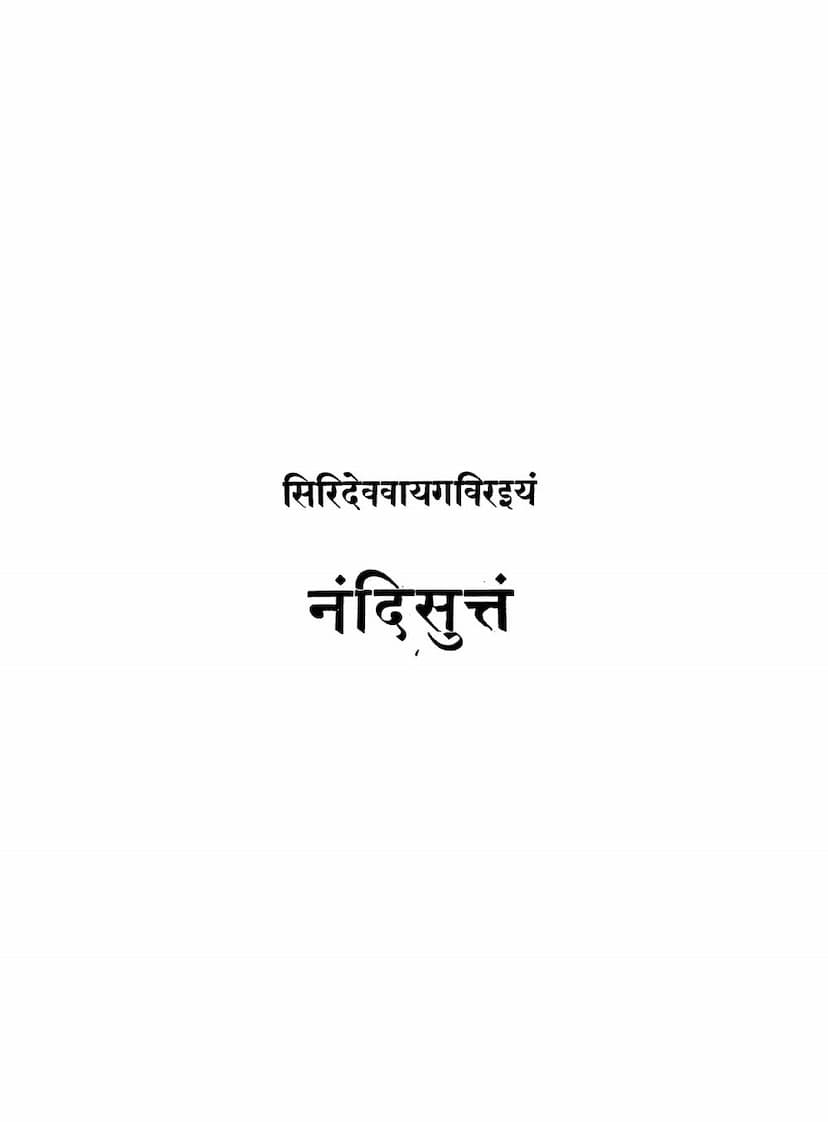Nandisuttam
Added to library: September 2, 2025

Summary
This document is a Gujarati translation of the Nandi Sutra, a foundational text in Jainism. The Nandi Sutra, primarily attributed to Sri Devavachaka, serves as an introduction to Jain scripture and principles. It is divided into several sections, each dealing with a specific aspect of Jain doctrine and practice.
Here's a breakdown of the key themes covered in the provided text:
1. Invocation and Praise:
- The text begins with an invocation to Lord Mahavir and a praise of the Tirthankaras (spiritual leaders).
- It also includes a hymn praising the Sangha (the Jain monastic community).
2. Tirthankara and Ganadhara Lineage:
- The Nandi Sutra lists the lineage of the 24 Tirthankaras, starting with Rishabhadeva and concluding with Mahavir.
- It then lists the Ganadharas (chief disciples of the Tirthankaras), detailing the ten principal disciples of Lord Mahavir.
3. Classification of Knowledge (Jnana):
- A significant portion of the text is dedicated to explaining the different types of knowledge in Jainism:
- Paryakshya (Direct Knowledge): This is further divided into:
- Indriya Paryakshya (Sensory Knowledge): Covering knowledge gained through the five senses (sight, sound, smell, taste, touch).
- No-Indriya Paryakshya (Non-Sensory Knowledge): This includes:
- Avadhi Jnana (Intuitive Knowledge): Knowledge of forms, time, and space that transcends sensory perception.
- Manahparyaya Jnana (Telepathic Knowledge): The ability to understand the thoughts of others.
- Kevala Jnana (Omniscience): Complete and absolute knowledge.
- Parokshya (Indirect Knowledge): This is divided into:
- Abhinibodhika Jnana (Sensory and Mental Knowledge): The initial understanding of sensory and mental perceptions.
- Shruta Jnana (Scriptural Knowledge): Knowledge acquired through scriptures and teachings.
- Paryakshya (Direct Knowledge): This is further divided into:
4. Detailed Explanation of Abhinibodhika Jnana:
- The text elaborates on Abhinibodhika Jnana, breaking it down into:
- Sunishitam (Clear and Distinct): Knowledge that is precise and unambiguous.
- Asunishitam (Unclear or Vague): Knowledge that is less defined.
- It further details sub-categories of Sunishitam, such as Uggraha (initial perception), Iha (investigation), Avaya (conclusion), and Dharana (retention), explaining their nuances.
5. Detailed Explanation of Shruta Jnana:
- The text then delves into Shruta Jnana, categorizing it based on various factors:
- Akshara Shruta (Literate Knowledge): Knowledge derived from written or spoken words.
- Anakshara Shruta (Illiterate Knowledge): Knowledge gained through non-linguistic means.
- Sannishruta (With cause/analysis) vs. Asannishruta (Without cause/analysis): Knowledge based on logical reasoning versus knowledge acquired through intuition or inference.
- Samyak Shruta (Right Scriptural Knowledge) vs. Mithya Shruta (Wrong Scriptural Knowledge): Differentiating between correct and incorrect understanding of scriptures.
- Sadiyam (With beginning) vs. Anadiyam (Without beginning): Knowledge that has a defined origin versus knowledge that is eternal.
- Sakalikam (Perishable) vs. Akalikam (Imperishable): Knowledge that can be lost versus knowledge that is permanent.
- Gamiyam (Understandable) vs. Agamiyam (Not understandable): Knowledge that is comprehensible versus knowledge that is beyond comprehension.
- Angapravishṭa (Belonging to the Angas/Sacred Texts) vs. Angabahira (Outside the Angas): Knowledge contained within the canonical scriptures versus knowledge found elsewhere.
6. The Twelve Angas of Jain Scripture:
- The Nandi Sutra provides a detailed description of the twelve Angas (limbs or sections) of the Agamas (Jain scriptures), which are considered the foundational texts. These include:
- Acharanga Sutra (Conduct)
- Sutrakritanga Sutra (Study of external philosophies and heresies)
- Sthananga Sutra (Classification of elements)
- Samavayanga Sutra (Analysis of the principles of Jainism)
- Vyakhya Prajnapti Sutra (Commentary on the Jain philosophy)
- JnAtAdharma KathA Sutra (Stories of religious conduct)
- UpAsakadasA Sutra (Discourses on lay disciples)
- Antakr̥dasa Sutra (Discourses on ascetics who have reached liberation)
- AnuttaropapAtika Dasa Sutra (Discourses on celestial beings)
- PraShna VyAkaraNa Sutra (On grammar and the meaning of words)
- VipAka Shruta Sutra (On the consequences of actions)
- DrishtivAda Sutra (On valid and invalid views)
- For each Anga, the text describes its content, its importance, and its structure.
7. Classification within Drishtivada:
- The Drishtivada, the twelfth Anga, is further categorized into:
- Parikarma (Preliminaries)
- Sutra (Aphorisms)
- Purvagata (Former texts)
- Anuyoga (Commentaries)
- Chulikas (Appendices)
8. Detailed Breakdown of Parikarma and Sutra:
- The text then provides a detailed classification of Parikarma into seven types and Sutra into twenty-two types, listing their respective sub-classifications.
Overall Purpose and Significance: The Nandi Sutra is considered a crucial text for beginners in Jainism. It provides a systematic and comprehensive overview of the fundamental tenets of the faith, including the nature of reality, the types of knowledge, the importance of scriptural study, and the structure of Jain literature. It serves as a guide for understanding the vast body of Jain teachings and a foundation for deeper spiritual practice.